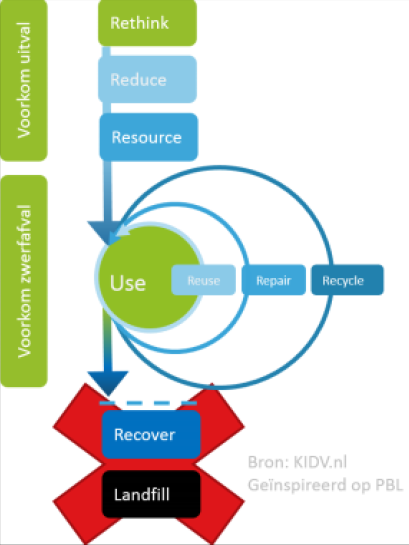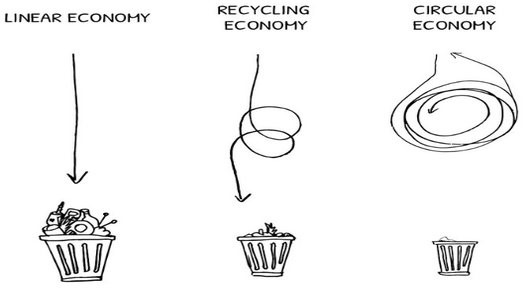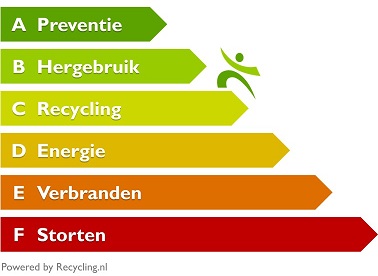The Sustainable Dictionary
5-R - The five Improvement directions

Bamboo is a fast-growing grass species that is extremely suitable for making paper. It is compostable, recyclable and has a sustainable look. More information on the page about
sleeves made of this material.
Bio-based/ Bioplastic
A material is made on the basis of the residual flows of renewable, natural resources such as potatoes, corn or cane sugar. These are renewable raw materials, which are currently not recycled separately. How does that work? You can read an explanation of
Milieucentraal here.
Biological
Of biological origin, grown or kept without the use of chemical pesticides and antibiotics.
The extent to which a substance can be broken down in nature. Bacteria often play an important role in this.
Circular
A recurring system where there is no start and end by reusing products and materials.
Circular economy
 Source: Het Kennisinstituut Duurzaam Verpakken KIDV
Source: Het Kennisinstituut Duurzaam Verpakken KIDV
An economic system that is intended to maximize the reusability of products and raw materials and to minimize value destruction. Unlike the current linear system, in which raw materials are converted into products that are destroyed at the end of their life.
A process whereby vegetable residues and food residues are broken down into fertile soil (humus) in the presence of oxygen for reuse in parks and gardens.
Cradle to cradle
(C2C or cradle-to-cradle) is a design philosophy based on the principle that waste equals food. Every raw material and every material must be able to be fully reused without losing its value.
Long lasting, good for people and nature. Use an area in such a way that natural resources do not run out. So for example not only felling trees, but also planting them again.
Ecological
Environmentally friendly with regard to the economy.
Environment
The whole of the atmosphere, soil and water that affect plants, animals and people.
Fair Clothing
Clothing made with care for people and the environment, fair wages and sustainable production.
Fair-Trade
Trade whereby producers in third world countries are paid a price that is considered fair. Stricter environmental requirements are imposed on fair trade products.
A footprint is a way of seeing what the impact of something is on the environment. This 'something' can be anything: a company, a service, a product, a trip, etc. A footprint comes in many different forms. A very well-known one is the carbon footprint (CO2), which is about climate change.
The Forest Stewardship Council (FSC) system ensures that the forests of our world can be preserved through responsible forest management. A well-managed forest runs less risk of being cut down for other purposes, such as the construction of palm oil or soy plantations and mining. By using FSC certified items, you contribute directly to the protection of our global forests and to a healthy living environment for humans and animals worldwide. Because the forest gets economic value in this way, we ensure that it is preserved. And that is important, because everyone wants to continue to enjoy eternally both our forests and the natural products of wood and paper?
Wood and paper products that come from an FSC-certified forest can be recognized by the FSC label
To ensure that products with this quality mark actually come from a responsibly managed forest, all links in the product chain must be certified.
Only when a forest manager, the paper mill and the wholesaler can demonstrate compliance with the rules of FSC, can a product be sold as an FSC and the logo placed on it. The more demand there is for FSC products, the more hectares of forest will be managed according to FSC guidelines. And the more people and animals who depend on the forest will benefit from this. More information about FSC. We are registered under number FSC-C148914 at the FSC certificate. Ask for our FSC® certified products.
The Floriculture Sustainability Initiative was initiated in 2012 by 25 stakeholders in the floriculture sector, the founders of FSI. They share the goal of finding more sustainable solutions for farmers, for the environment and for the future of the sector, and have set themselves the ambition to have 90% of flowers and plants produced and marketed in a responsible manner by 2020. For this they have drawn up a basket of standards.
Hydropaper
Water-resistant paper that is compostable. Is collected in the old paper. Koen Pack has developed a number of sleeves with this material,
especially for plants. But much more
for flowers.
Kraft paper
Kraft paper is a very strong type of paper made from wood chips from coniferous wood. The wood chips mainly come from tree species such as spruce and pine, because they have a long fiber. This long fiber ensures the strength and high quality of the paper. During the processing of wood fiber into paper pulp, the natural binding agent lignin is separated from the cellulose, resulting in a very pure product. The kraft paper used for our products is unbleached and has a natural brown color. The paper is wet-strong and, due to its pure composition, very suitable for recycling and composting. Because the material is made from fast-growing tree species, the product is also very durable.
Linear economy
A system in which raw materials are converted into products that are destroyed at the end of their lifespan.
Litter
Waste on the street, on the roadside or in ditches and lakes. It is annoyance number one and is also bad for nature, people and animals.
Micro beads
Tiny plastic balls that are used in beauty products such as toothpaste, day cream and shower gel.
Corporate Social Responsibility, an organization that focuses on sustainability and new business models. More information about
MVO Nederland.
Natural materials
Product whose ingredients come from nature, such as tree bark, pine cones or birch bark.
The Belgian quality mark OK Compost is printed on bags, covers and trays made of compostable plastic. The advice is to throw bioplastic with the OK Compost logo in the trash bin. It only composts after 12 weeks in a special composting machine. In practice, organic waste is only in such a machine in the Netherlands for 1 to 2 weeks and pieces of plastic are left behind in the compost. This is not desirable.
PET
Polyethylene Terephthalate, is used for plastic drinking bottles. Because there is deposit on it, the recycling process is well designed for this material.
Polylactic Acid, a bioplastic made from renewable sources such as corn, this is not at the expense of food because the stems and leaves are used for production. It is a compostable raw material when it can remain in a professional composting installation for more than 10 weeks. In the Netherlands the process is shorter, so it is preferable to throw it in the gray bin.
A plant passport is a collection of mandatory information that must be documented when all plants intended for planting within the European Union (EU) are traded. It shows the identity and origin of the shipment and makes it possible to trace the original producer. A plant passport has a fixed format. The presence of a plant passport proves that the producer complies with the applicable rules and requirements set out in the European Plant Health Regulation (EU) 2016/2031 and that the company falls under an inspection regime of an inspection service.
Plastic
It consists of chemical compounds produced by non-natural chemical processes. The raw material is often hydrocarbon, which comes from petroleum, a fossil fuel. Some examples are PP, PET, PS, LDPE and HDPE. Nowadays there are also plastics made from renewable materials such as PLA.
Plastic Pact
A lot of plastic floats in the sea, from large pieces on the water to almost invisible pieces of microplastics under water. This is called the plastic soup. There are various organizations active in combating this. If you want to know more about this, take a look at
Plastic Soup Foundation.
Plastic soup
The Plastic Pact NL has been signed by a crowd of parties from the plastic chain. The ambitions of the Plastic Pact NL certainly do not lie. To give an example: by 2025, all single-use plastic products and packaging must be 100 percent recyclable. The amount of plastic that we use in the Netherlands must have fallen by 20 percent in the same year and 70 percent of one-off plastic products must be recycled in high quality by that time.
To achieve those objectives, a chain approach is required, the Pact states. In other words: important steps can be taken during the design, use and recycling phase. The pact emphasizes the importance of a simplified chain, so that plastic products and packaging can be recycled more efficiently and with higher quality.
Source: Duurzaam Bedrijfsleven.
Quality mark
Mark as proof of inspection and / or indication of a certain quality.
Recycling / recycling / recyclable
Reusing materials. Watch this informative video
from the Klokhuis about how that works in practice.
Waste hierarchy / Lansink's ladder

Defined in the EU Waste Framework Directive (2008/98/EC on waste). Requires that EU Member States dispose of waste according to the waste hierarchy at five levels: prevention, preparation for reuse, recycling, other recovery and disposal.

 Source: Het Kennisinstituut Duurzaam Verpakken KIDV
Source: Het Kennisinstituut Duurzaam Verpakken KIDV
